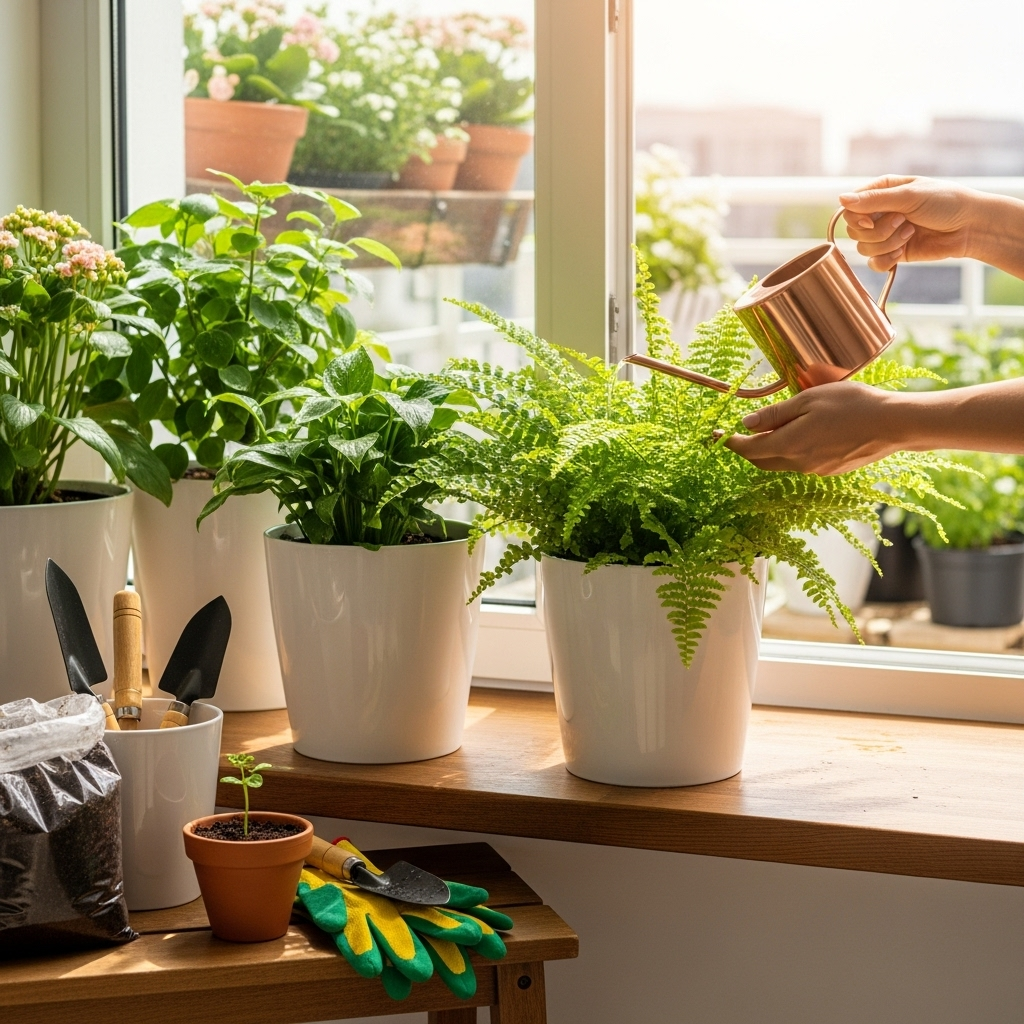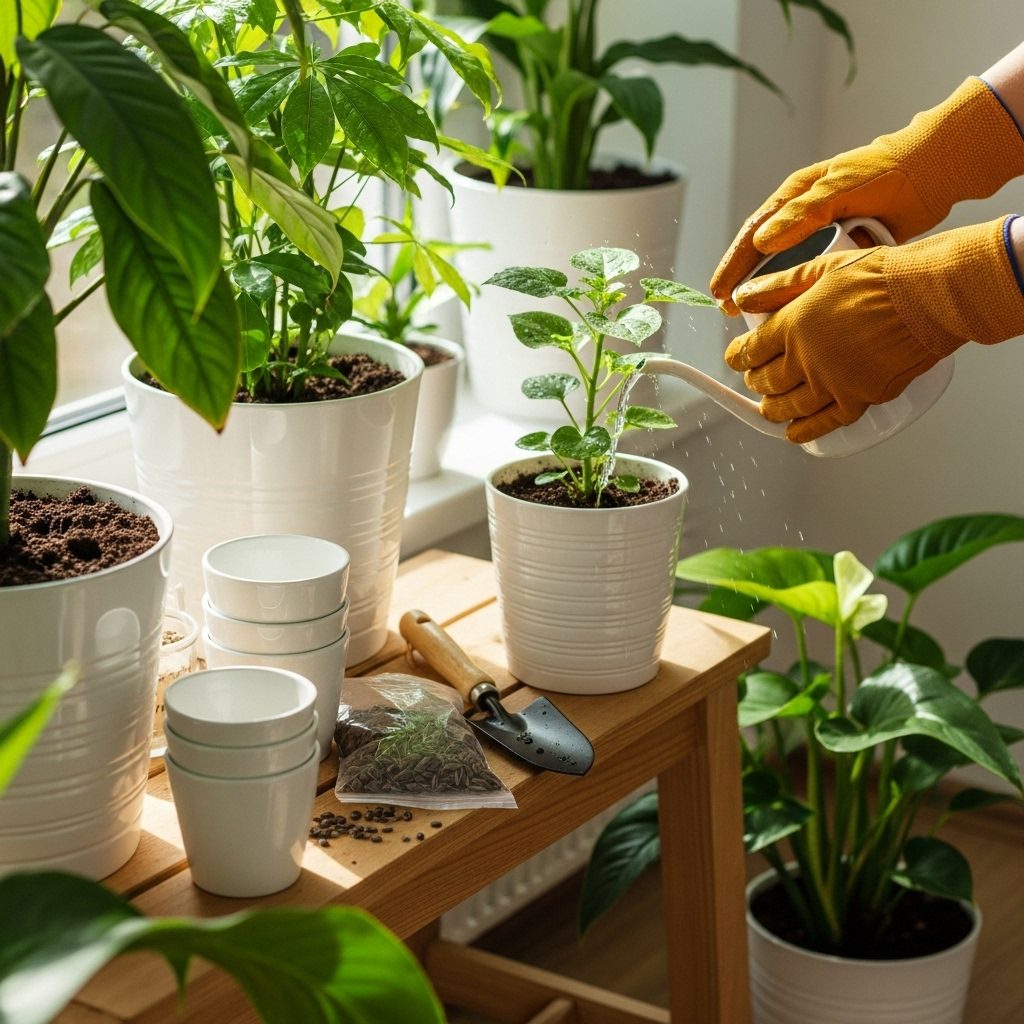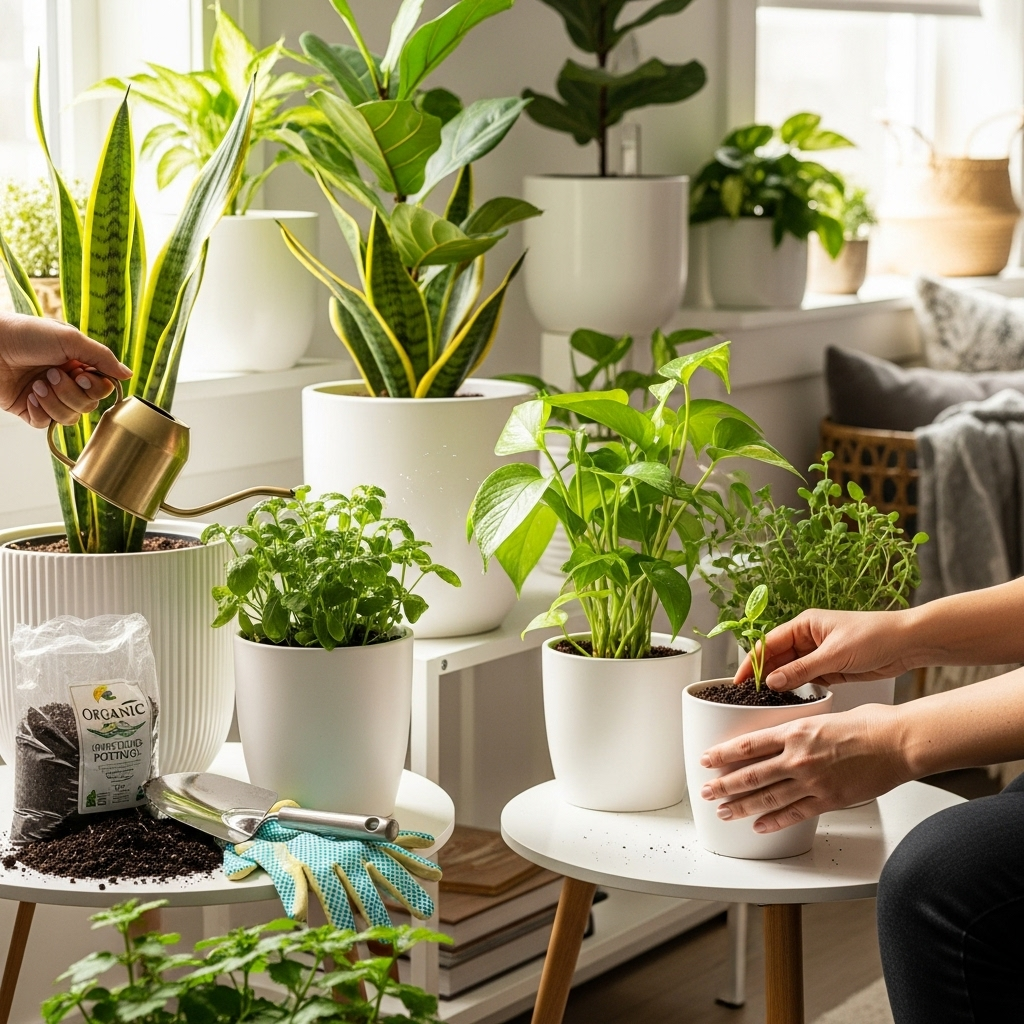White indoor pots are a versatile and stylish choice for any plant lover, offering a clean, bright backdrop that makes plants pop and elevates home decor while being budget-friendly and easy to find.
Hello there, green thumb friend! Are you looking to add a touch of calm and sophistication to your indoor jungle? Perhaps you’ve noticed how some plants just seem to glow when placed in the right container. If you’re wondering how to achieve that effortlessly chic look, you’re in the right place! Many folks find choosing the perfect pot can be a little overwhelming. You want something that complements your plant and your home, but also helps your leafy friend thrive. Today, we’re diving into the wonderful world of white indoor pots – a simple yet stunning solution that’s practically a magic wand for plant styling!
White pots are more than just a pretty face; they’re a gardener’s best friend for a multitude of reasons. They create a luminous effect, making your vibrant green leaves and colorful blooms stand out beautifully. Plus, they fit seamlessly into almost any interior design style, from minimalist to bohemian. Ready to discover why white pots are an essential pick for every plant parent? Let’s get to it!
Why White Indoor Pots Are a Gardener’s Dream
Choosing the right pot isn’t just about looks; it’s about giving your plants the best environment to grow. White pots offer a brilliant combination of aesthetic appeal and practical benefits that make them an absolute staple for indoor plant enthusiasts. Let’s break down why they shine so brightly in the world of plant parenting.
Aesthetic Versatility: The Blank Canvas Effect
Think of a white pot as the ultimate neutral backdrop for your botanical beauties. No matter your home’s style – modern, farmhouse, bohemian, or classic – white pots blend in with grace. They don’t compete with the plant’s natural beauty; instead, they enhance it. This makes your plants the true stars of the show, ensuring their vibrant greens and intricate leaf patterns are the main attraction. This versatility also means you can rearrange your plant display without worrying about clashing pot colors!
Brightening Your Space
White has a magical way of reflecting light. In a room that might be a bit dim, white indoor pots can help bounce natural and artificial light around, making your space feel brighter and more open. This is especially beneficial for plants that thrive in bright, indirect light, as the pot itself can contribute to the overall illumination of their immediate environment. It’s like giving your plants a little halo!
Making Plants Pop
Ever notice how a brightly colored flower stands out against a white background? The same principle applies to your green friends. The verdant hues of foliage, from deep emerald to bright lime, contrast beautifully with a clean white pot. This contrast makes your plants look even more lush and vibrant, drawing the eye and creating stunning visual interest in your home.
Budget-Friendly and Accessible
One of the most delightful aspects of white indoor pots is their availability and affordability. From budget-friendly terracotta pots painted white to sleek ceramic options, you’ll find them everywhere. Major retailers, garden centers, and even DIY stores offer a wide range of styles and sizes. This makes it easy to build a cohesive collection without breaking the bank, allowing you to pot up more plants!
Promoting Cooler Root Temperatures (with caveats)
Unlike dark-colored pots that absorb sunlight and can heat up, white pots reflect sunlight. This means they tend to stay cooler, which can be beneficial for the root systems of some plants, especially those sensitive to overheating. However, it’s important to remember that this effect is more pronounced with materials like terracotta. Glazed ceramic pots, regardless of color, tend to insulate more, so while white is still a good choice, the cooling effect might be less dramatic.
Choosing Your Perfect White Pot: Materials & Features

When you’re on the hunt for white indoor pots, you’ll find a variety of materials, each with its own charm and practical considerations. Understanding these differences will help you pick the best pot for each of your green companions and your home environment.
Material Matters: Pros and Cons
| Material | Pros | Cons | Best For |
|---|---|---|---|
| Ceramic (Glazed) | Aesthetically pleasing, durable, holds moisture well, available in many stylish white finishes. | Can be heavy, less breathable meaning risk of overwatering, can be pricey. | Plants that prefer consistent moisture, decorative display plants, medium to large plants. |
| Terracotta (Painted White) | Affordable, breathable (if unglazed underneath paint), lightweight, classic look. | Paint can chip over time, less water-retentive than glazed ceramic, can stain. | Plants that like to dry out between waterings, starting out, budget-conscious decorating, herbs. |
| Plastic/Resin | Lightweight, durable, inexpensive, good at retaining moisture, easy to clean. | Can look less premium, less breathable, may degrade in prolonged direct sun. | Beginners, plants that need consistent moisture, large plants, high-traffic areas. |
| Fiberstone/Composite | Lightweight yet strong, durable, often has a matte finish, good for larger pots. | Can be more expensive, less breathable than terracotta. | Large statement plants, modern interiors, outdoor use (check UV resistance). |
Key Features to Look For
When selecting your white indoor pots, consider these crucial features to ensure your plants are happy and healthy:
- Drainage Holes: This is non-negotiable for most indoor plants! Ensure the pot has at least one hole in the bottom to allow excess water to escape. Root rot is a common killer of houseplants, and good drainage is the best prevention. If a pot you love doesn’t have a hole, you can often drill one (especially in plastic or terracotta) or use it as a cachepot (see below).
- Size Appropriateness: Your pot should be roughly 1-2 inches larger in diameter than the plant’s current root ball. A pot that’s too large can hold too much moisture, leading to root rot. Too small, and the plant will become root-bound, stunting growth.
- Saucers or Cachepots: Most pots with drainage holes will need a saucer to catch excess water. Alternatively, you can use a decorative pot without drainage holes (a cachepot) and place a nursery pot (with drainage holes) inside it. Remember to empty the cachepot after watering to prevent the plant from sitting in water.
- Material Finish: White pots come in various finishes – glossy, matte, textured. Glossy finishes are easy to clean but can sometimes feel a bit formal. Matte finishes offer a softer, more contemporary look and hide water spots better. Textured finishes add visual interest.
- Saucer Integration: Some pots come with attached saucers, which can be convenient. Others are sold separately, allowing you to mix and match for a different look.
A great resource for understanding plant needs regarding drainage and watering is the PennState Extension’s Houseplant Care guide, which offers practical advice for beginners.
Stylish White Pot Ideas for Every Plant and Space
White indoor pots offer endless styling possibilities! Whether you’re a minimalist at heart or love a bit of eclectic charm, there’s a white pot design for you. Here are some ideas to get your creative juices flowing.
Minimalist Marvels
For a clean, modern aesthetic, opt for simple white ceramic or matte plastic pots with clean lines. Think cylindrical shapes, smooth finishes, and no unnecessary embellishments. These pots are perfect for showcasing sculptural plants like snake plants (Sansevieria), ZZ plants, or a single, elegant fiddle-leaf fig. The simplicity of the pot allows the plant’s form and color to take center stage, creating a calming and sophisticated look.
Bohemian Dreams
Bring a touch of boho chic to your space with white pots that have a bit more texture or pattern. Look for pots with subtle ribbed designs, macrame hangers in neutral tones, or even hand-painted artisanal patterns. White terracotta pots, especially those with a slightly rustic feel, pair beautifully with trailing plants like Pothos or String of Pearls, adding a relaxed, lived-in vibe.
Farmhouse Charm
Embrace the cozy, rustic appeal of farmhouse decor with white pots that have character. Think classic white ceramic planters, perhaps with a subtle crackle glaze, or even repurposed white enamelware. These are wonderful for herbs in the kitchen, cheerful succulents on a windowsill, or a collection of small white pots housing different varieties of ferns. A grouping of various white pots on a wooden shelf can create a charming focal point.
Terracotta with a Twist
Don’t want to give up the breathability of terracotta? Many affordable terracotta pots can be easily transformed with a coat of white spray paint or chalk paint. This DIY approach is budget-friendly and allows you to get creative with finishes – matte, slightly distressed, or even a crisp, clean white. This is a fantastic option for plants that prefer to dry out between waterings, like succulents and cacti.
The Power of Patterns
White doesn’t have to mean plain! Consider white pots featuring geometric patterns, subtle stripes, or even modern abstract designs. These can add a playful yet sophisticated element to your plant display. A white pot with a black geometric pattern, for instance, can provide a graphic pop that complements a minimalist or modern mid-century interior.
Groupings and Collections
Creating a cohesive look often involves grouping pots together. A collection of white pots of varying sizes and similar styles can be visually striking. Arrange them on a shelf, a windowsill, or a side table. Mix different plant types within the collection for added visual interest – perhaps a tall, slender plant in one pot, a bushy one in another, and a trailing plant spilling over the edge of a third.
Caring for Your White Indoor Pots

Keeping your white indoor pots looking pristine is straightforward, but a few tips will ensure they remain a beautiful accent in your home for years to come.
Cleaning White Pots
- For Glazed Ceramic and Plastic Pots: A simple wipe-down with a damp cloth is usually sufficient for daily dusting. For stubborn dirt or water spots, use a mild dish soap diluted in water and a soft sponge or cloth. Rinse thoroughly and dry.
- For Terracotta Pots (Painted or Unpainted): If your terracotta pot is painted, avoid harsh scrubbing that could damage the paint. Use a damp cloth and mild soap if necessary, and always dry it completely. Unpainted terracotta can sometimes develop marks from watering; a gentle scrub with a baking soda paste (baking soda mixed with a little water) can help lift these stains. Always rinse well.
- Dealing with Algae or Mildew: If you notice any green patches (algae) or white powdery spots (mildew), especially on terracotta, it’s usually due to moisture. Mix a solution of equal parts white vinegar and water, or use diluted hydrogen peroxide. Gently scrub the affected areas and rinse thoroughly. Ensure the pot is fully dry before repotting.
Preventing Stains
The biggest culprit for staining white pots is water that has been sitting in the pot or saucer for too long, especially if it contains mineral deposits or fertilizer residue. Always empty saucers after watering. For terracotta, mineral salts can leach through the porous material and leave white or brown stains. While this is natural, you can minimize it by ensuring proper drainage and not letting the pot sit in standing water.
Maintaining Drainage
Over time, soil particles or mineral buildup can clog drainage holes, hindering water flow. Periodically cleaning out drainage holes with a small brush or a twig can help maintain proper drainage. If you notice water isn’t draining well, it might be time to repot your plant into fresh soil with clear drainage holes.
White Pots as Cachepots: A Stylish Secret
Cachepots are decorative containers without drainage holes, designed to sit over a plant’s nursery pot (the plain plastic pot it usually comes in). White cachepots are incredibly popular for achieving a polished look with minimal effort. Here’s how they simplify your plant care:
- Choose Your Cachepot: Select a beautiful white ceramic, metal, or woven cachepot that’s slightly larger than your plant’s nursery pot.
- Water Your Plant: Water your plant thoroughly in its nursery pot, allowing it to drain completely. This is crucial to avoid excess water pooling.
- Place and Display: Nest the drained nursery pot inside the white cachepot. Ensure it sits comfortably without touching the bottom if possible (you can use a few pebbles or a small riser to elevate it).
- Enjoy the Look: Admire your instantly updated, stylish plant display!
- Empty Excess Water: Every few days, or after watering, lift the nursery pot out of the cachepot and empty any collected water. This prevents the roots from sitting in water, which can lead to rot.
This method is perfect for those gorgeous pots that lack drainage, or if you simply want the flexibility to swap out plants easily without disturbing their soil. It’s a foolproof way to keep your white pots looking clean and your plants healthy.
Beyond the Basic White: Textures and Tones

While pure white is classic, don’t shy away from variations that can add depth and interest to your collection. Exploring different textures and subtle tonal shifts can elevate your plant styling.
Off-White and Creamy Hues
Sometimes, a perfect, bright white can feel a bit stark. Off-white, cream, or ivory pots offer a softer, warmer alternative. These shades can feel more inviting and blend more subtly with a variety of decor styles, particularly those with natural materials like wood or rattan. They still provide that light, airy feel without the potential for glare that pure white can sometimes have.
Textured Whites
- Ribbed Pots: These have vertical or horizontal indentations that add a subtle visual appeal and a tactile element.
- Speckled Pots: Pots with tiny flecks of other colors (black, grey, or brown) mixed into the white glaze create a more artisanal and less uniform look.
- Woven or Rattan-Style Whites: Many planters are made from plastic or other materials designed to mimic the look of woven baskets, often in white or off-white. These bring a natural, textural element into your home.
- Earthy Textures: Look for white pots with raku-style glazes, subtle stone textures, or even concrete-like finishes for a more organic and grounded feel.
These variations add personality and visual interest, making your plant display feel more curated and less like it came straight off a factory line. They are especially great for breaking up a large collection of identical pots.
DIY White Pot Makeovers: A Budget Gardener’s Best Friend
Got a collection of boring brown terracotta pots or perhaps some outdated planters? Give them a new life with a fresh coat of white paint! This is one of the easiest and most rewarding DIY projects for plant lovers.
Simple Spray Painting Technique
- Prep Your Pots: Make sure your pots are clean, dry, and free of any dust or debris. For terracotta, a quick rinse and thorough drying is usually enough. If painting over a glossy finish, a light sanding can help the paint adhere better.
- Choose Your Paint: Opt for spray paint designed for multi-surface use or specifically for crafts. Matte white spray paint provides a chic, modern finish, while satin or gloss finishes offer a different look. For terracotta, ensure the paint is suitable for porous surfaces.
- Find a Ventilated Area: Work outdoors or in a well-ventilated space like an open garage. Lay down drop cloths or old newspapers to protect the surface.
- Apply Thin Coats: Hold the spray can about 8-12 inches away from the pot. Apply light, even coats, moving back and forth. It’s much better to apply several thin coats than one thick one, which can lead to drips and uneven coverage.
- Allow to Dry: Let each coat dry according to the manufacturer’s instructions, usually 15-30 minutes, before applying the next. You’ll typically need 2-3 coats for full coverage.
- Cure Time: After your final coat, let the pots cure completely for at least 24 hours (or longer, as recommended by the paint manufacturer) before adding soil and plants. This ensures the paint is durable and won’t be damaged by moisture.
Once dry, your transformed pots will look like high-end designer pieces, ready to house your favorite green friends! This method is also great for adding drainage holes to pots – for terracotta and some plastics, a drill with a masonry bit can often do the trick for creating or enlarging drainage holes.</


